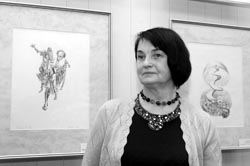Dante visits Shevchenko
The unique research on the images of The Divine Comedy
The launch of Olha Petrova’s titanic work Commedia by Dante Alighieri. Artistic commentary of the 14-20th centuries is a noteworthy event in Ukrainian cultural life, according to critics. The book and exhibit of works by famous graphic artists, as well as Medieval illustrations (reproductions), were presented in the Taras Shevchenko National Museum. They were accompanied by old-age music of European composers, performed by the Old-Age Music Ensemble conducted by Kostiantyn Chechenia.
Petrova’s research is unique because of its thorough analysis, but also because it includes 370 illustrations featuring frescoes, paintings and sculptures. These are artists’ responses, over six centuries (14 through 20th centuries), to the renowned work of the talented medieval Florentine poet.
“I started working on this subject back in the 1970s,” Olha told The Day, “It grew from my thesis. At first I took an interest in the Dante topic as an artist. On my graduation from the Lviv Graphic School the titans, such as Hryhorii Kochur, Mykola Lukash, and Ivan Drach gave me materials for my work. In 1972-74 I created a series of graphic pieces. When Dmytro Pavlychko published them in the magazine Vsesvit, the ideological department of the TsK KPU noted that my works were ‘surrealistic, and this artist should be prevented from working in Ukraine.’ After being blacklisted, I lost my job, so I had to work as an illustrator. Understanding that it was difficult for me to live and work in Ukraine, I went to the Moscow Institute of Art Studies at the Ministry of Culture, which at the time gathered the most progressive art critics from around the USSR. There I wrote a thesis, but it has lain on the shelf for quite a long time. The whole process took nearly 30 years. I was still completing my work on Dante, when I met the head of the Italian Institute of Culture, Prof. Niccolo Franko Balloni. He saw the illustrations and manuscript and said that a book should be written based on them. At his suggestion the work was completed within two years, and its publication was funded by the Italian Institute of Culture.”
The book is written in two languages, Ukrainian and English, the translation was done by Andrii Kulykov.
“Studying Dante’s life in art of the period between the 14th and 20th centuries, I concluded that Dante has not run out of date in our days either, that all the present-day conflicts were also present in Florence in the 14th century,” the author said. “He is a very poetic, patriotic, and attentive interlocutor. One who has been deeply affected by his personality will understand me.”
Petrova’s work includes an analysis of the world’s interpretations of The Divine Comedy images of the 15th century (The Siena Code, the Urbino Code 365), notably within the extended Slavic Bloc with illustrations executed by artists of Ukraine, Poland, the Czech Republic, and Russia. The significance of the work is confirmed by the fact that it was nominated for Ukraine’s Taras Shevchenko National Prize.
“Petrova’s research is not merely a tribute paid to the author’s affection for the medieval poet, it roots European culture in Ukaine,” professor at La Sapienza University and Ukraine’s Taras Shevchenko Institute of Literature, Oxana Pachliovska, believes, “Importantly, the broader this cultural space is, the less place is left for the horde of enslavers. It is difficult to create, as it must be reconquered from other spaces.”
Once rejected by the Soviet censorship, Petrova’s graphic works from the Divine Comedy Series are now on display at the exhibit held at the Taras Shevchenko National Museum. In stormy 1970s, her illustrations were on display in Florence and received high praise from the Italians, even by the Pope himself. They are exhibited alongside of the works of Ukrainian engravers, including Natalia Aleksenko, whose diploma paper in 1997 was an illustration project for The Divine Comedy. The exhibit also presents works by Hryhorii Havrylenko. In 1965, at Mykola Bazhan’s instruction, he executed an ink and pen cycle of illustrations to Dante’s La Vita Nuova. The works are interesting because the artist begins with naturalism and executes illustrations in the plane fresco manner. Russian graphic illustrator Mikhail Pikov, Vladimir Favorsky’s student, is also worthy of attention. In 1961 he executed the compositions of 99 woodcut, specific in terms of plastics and mastery, illustrations to three chapters of The Comedy. It is the first time that these author’s imprints are exhibited in Ukraine.






